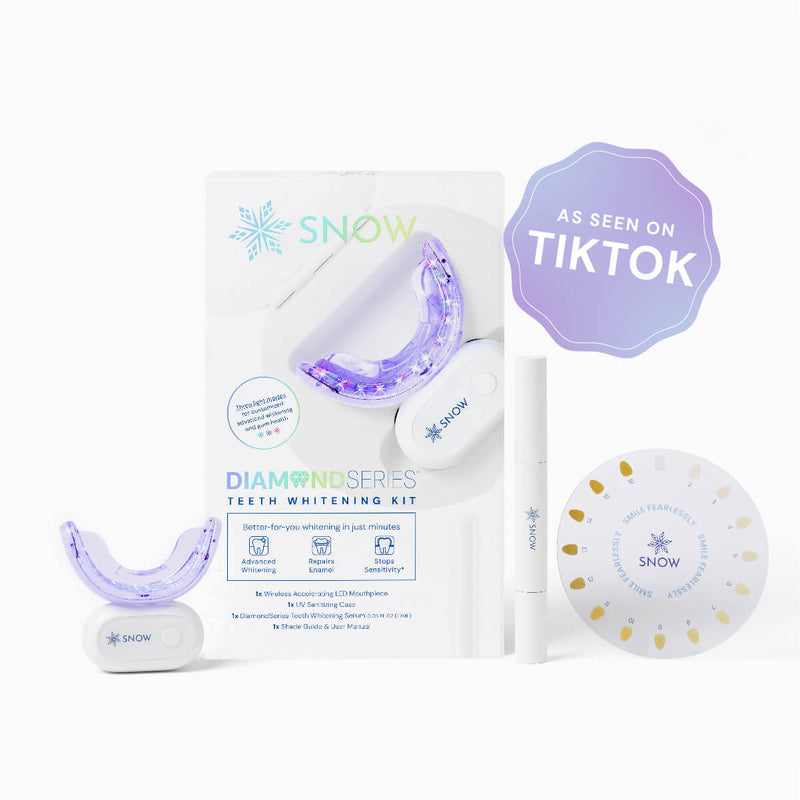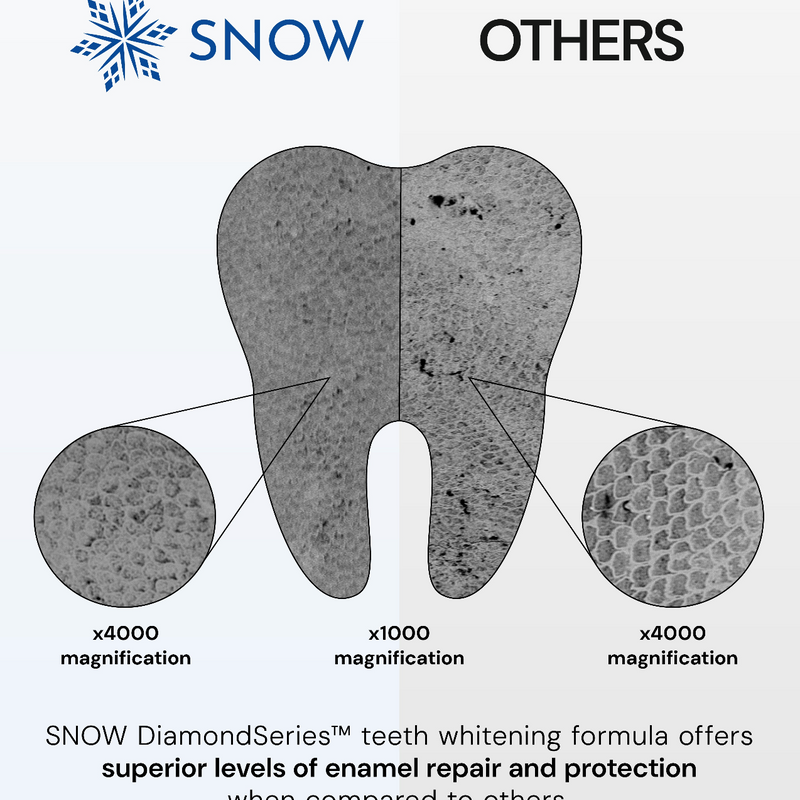Wondering about using hydrogen peroxide to clean your toothbrush? Yes, it's an effective method.
At SNOW, we advocate for safe and efficient at-home dental care practices.
In this article, we'll explore the benefits of using hydrogen peroxide to clean toothbrush heads, answering your queries directly. Our expertise in dental health ensures reliable information to help you maintain oral hygiene.
We'll delve into the step-by-step process of disinfecting your toothbrush, highlighting its safety and effectiveness.
Additionally, we'll provide tips and alternatives for toothbrush disinfection.
Trust SNOW to guide you in achieving a brighter and healthier smile with our expert-backed advice.
What this article covers:- Hydrogen Peroxide: A Safe and Effective Disinfectant
- Why Disinfecting Your Toothbrush Is Important
- How To Disinfect Your Toothbrush Using Hydrogen Peroxide
- Tips For Disinfecting Your Toothbrush
- Should You Disinfect Your Toothbrush If You're Sick?
- How Else Can You Disinfect A Toothbrush?
Hydrogen Peroxide: A Safe and Effective Disinfectant
At SNOW, we understand the importance of maintaining proper hygiene to ensure a healthy and bright smile.
Hydrogen peroxide is one of the key ingredients in our teeth whitening products, known for its effectiveness in disinfecting toothbrushes and promoting oral hygiene.
Our Daily Hydroxyapatite Teeth Whitening Toothpaste harnesses the whitening power of hydrogen peroxide to gently polish away surface stains and brighten your smile with regular use. Its fluoride formula helps strengthen enamel and protect against cavities.

For on-the-go whitening and maintenance, our Magic Teeth Whitening Strips offer convenience and efficacy. Infused with hydrogen peroxide, these strips adhere securely to your teeth, delivering professional-level whitening results in the comfort of your own home [2].
To complement your oral care routine, use our LED Teeth Whitening Electric Toothbrush to combine advanced technology with the power of hydrogen peroxide to provide a comprehensive oral care experience.
With its gentle bristles and customizable settings, it effectively removes plaque and stains while disinfecting your toothbrush after each use.
By incorporating these SNOW products into your daily regimen, you can enjoy a cleaner, healthier mouth and achieve the dazzling smile you deserve.
Advantages Of Using Hydrogen Peroxide
At SNOW, we advocate for the use of hydrogen peroxide in at-home teeth whitening for several reasons:
Affordability
Hydrogen peroxide is a cost-effective option for maintaining oral hygiene. Available at most pharmacies and grocery stores, it provides an economical solution for teeth whitening.
Effectiveness
As a potent disinfectant, hydrogen peroxide effectively eliminates bacteria, viruses, and fungi from surfaces, including toothbrushes. By incorporating hydrogen peroxide into your oral care routine, you can ensure a clean and hygienic environment for your teeth.
Safety
When used as directed, hydrogen peroxide is considered safe for oral hygiene practices. It poses minimal risk of adverse effects and is widely recommended by dental professionals for its efficacy in maintaining oral health.
By leveraging the affordability, effectiveness, and safety of hydrogen peroxide, individuals can achieve brighter smiles and improved oral hygiene from the comfort of their own homes.

Why Disinfecting Your Toothbrush Is Important
Disinfecting your toothbrush is crucial for maintaining optimal oral health and preventing the spread of harmful bacteria.
Over time, toothbrushes can harbor various bacteria, including streptococcus, E. coli, and staphylococcus aureus, which can lead to oral infections, cavities, and gum disease.
When you brush your teeth, bacteria from your mouth can transfer to the bristles of your toothbrush.
If not properly disinfected, these bacteria can multiply and thrive in the moist environment of the bristles, increasing the risk of oral health issues.
Regularly disinfecting your toothbrush helps to eliminate these harmful bacteria, ensuring that each time you brush, you're not reintroducing harmful pathogens into your mouth.
It's especially important for individuals with compromised immune systems, as they are more susceptible to infections caused by bacteria on toothbrushes.
At SNOW, we emphasize the importance of proper hygiene practices to maintain a healthy and bright smile. By incorporating toothbrush disinfection into your oral care routine, you can take proactive steps to safeguard your oral health and overall well-being.
How to Disinfect Your Toothbrush Using Hydrogen Peroxide
Disinfecting your toothbrush or toothbrush head with hydrogen peroxide is a straightforward process that ensures your oral hygiene tools remain clean and bacteria-free.
Here's a step-by-step guide:
1. Prepare The Solution
According to Healthline, mix equal parts hydrogen peroxide and water in a clean container. This solution effectively kills germs and bacteria lingering on your toothbrush.
2. Soak Your Toothbrush
Submerge the bristles of your toothbrush in the hydrogen peroxide solution. Let it soak for about 10 minutes to allow the hydrogen peroxide to penetrate and disinfect the bristles thoroughly.
3. Rinse Thoroughly
After the soaking period, rinse your toothbrush under cold water. This step removes any residual hydrogen peroxide from the bristles, ensuring it doesn't come into contact with your mouth during brushing.
4. Air Dry
Place your toothbrush in an upright position to air dry completely. This prevents moisture buildup and bacterial growth on the bristles, maintaining optimal oral hygiene.
By following these simple steps, you can effectively disinfect your toothbrush using hydrogen peroxide, promoting better oral health and hygiene.

Tips for Disinfecting Your Toothbrush
Ensuring your toothbrush remains clean is essential for maintaining good oral hygiene.
At SNOW, we understand the importance of proper toothbrush care to promote a healthy smile.
Here are some valuable tips to help you disinfect your toothbrush effectively:
Frequency
Regularly disinfecting your toothbrush is crucial to prevent the buildup of bacteria and germs. We recommend disinfecting your toothbrush at least once a week to maintain optimal oral hygiene.
This practice helps ensure that you're not reintroducing harmful bacteria into your mouth every time you brush.
Replace Regularly
In addition to regular disinfection, it's essential to replace your toothbrush regularly to maintain its effectiveness. We advise replacing your toothbrush every three to four months, or sooner if you notice that the bristles have become frayed or worn out.
Over time, toothbrush bristles can deteriorate, reducing their ability to clean your teeth properly. By replacing your toothbrush regularly, you can ensure that you're effectively removing plaque and debris, promoting a brighter and healthier smile.
Should You Disinfect Your Toothbrush If You're Sick?
Yes, it's essential to disinfect your toothbrush if you're sick. When you're ill, your toothbrush can become a breeding ground for harmful bacteria and viruses, posing a risk of reinfection.
Disinfecting your toothbrush helps eliminate these pathogens, reducing the chances of spreading illness and promoting faster recovery.
Hydrogen peroxide is a highly effective disinfectant commonly used for cleaning toothbrushes. It has strong antimicrobial properties that can kill a wide range of germs, including bacteria and viruses.
By soaking your toothbrush in hydrogen peroxide solution for a few minutes, you can effectively sanitize it and minimize the risk of contaminating your mouth with harmful microorganisms.
Regularly disinfecting your toothbrush, especially during illness, is a simple yet powerful way to maintain oral hygiene and safeguard your health.
At SNOW, we prioritize providing our customers with the knowledge and tools they need to achieve a healthy, radiant smile even during challenging times.
How Else Can You Disinfect a Toothbrush?
Wondering about alternative methods to disinfect your toothbrush at home? SNOW has got you covered with these effective options:
- Antibacterial Mouthwash: According to WebMD, soaking your toothbrush in antibacterial mouthwash, like our Artic Frost Teeth Whitening Mouthwash, for a few minutes can effectively kill germs and bacteria. It's a simple and convenient way to ensure your toothbrush stays clean and hygienic.
- Baking Soda: Baking soda is not just for baking cakes; it's also a fantastic cleaning agent for your toothbrush. Creating a paste with baking soda and water and using it to scrub your toothbrush can help remove bacteria and plaque buildup, leaving your toothbrush fresh and clean.
- Denture Cleansers: If you have denture cleansers lying around, you can use them to disinfect your toothbrush as well. These cleansers are often suitable for toothbrushes, but make sure to follow the instructions on the product label for proper usage to ensure effective disinfection.
By incorporating these alternative methods into your oral care routine, you can maintain a clean and hygienic toothbrush for optimal dental health.
Conclusion
Harness the power of hydrogen peroxide to keep your toothbrush pristine. With affordable, effective, and safe methods like mouthwash, baking soda, and denture cleansers, maintaining oral hygiene has never been easier.
Ensure your toothbrush remains free from harmful bacteria and germs with these simple yet powerful solutions. Don't compromise on cleanliness when it comes to your dental health.
Discover more about teeth whitening with SNOW's innovative products, designed to elevate your oral care routine.
For more tips on maintaining a bright and healthy smile, check out SNOW's LED Teeth Whitening Electric Toothbrush and range of teeth whitening products.
If you want to learn more, why not check out these related posts:
- Can I Soak My Toothbrush in Hydrogen Peroxide
- Does Vinegar Kill Strep on Toothbrush
- Does Hydrogen Peroxide Kill COVID on Toothbrushes
- Can You Disinfect a Toothbrush with Rubbing Alcohol
- Will Peroxide Kill Thrush on Toothbrush
- When to Change Toothbrush After Strep
- Electric Toothbrush Hurts My Teeth
- Gums Hurt After Brushing with New Toothbrush
- Why Change Toothbrush Every 3 Months?
- Why Is My Toothbrush Turning Pink?
- Best Electric Toothbrush for Small Mouths
- Best Electric Toothbrush
- Best Toothbrush for Veneers
- Best Toothbrush for Cavities
- Best Flossing Toothbrush

























